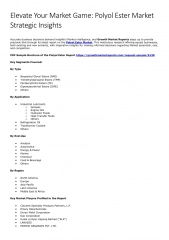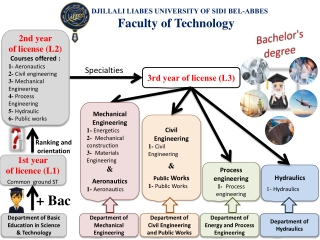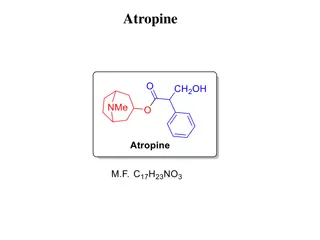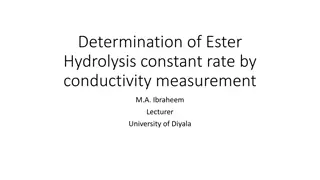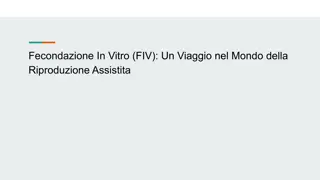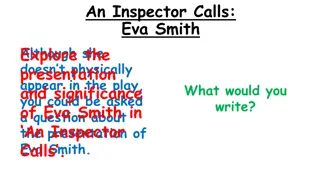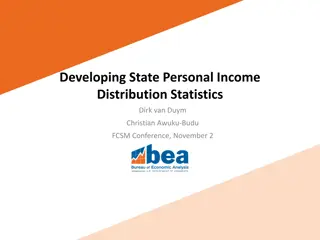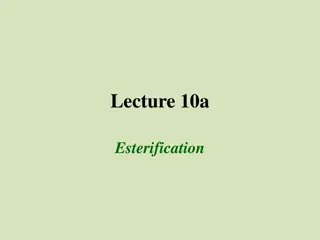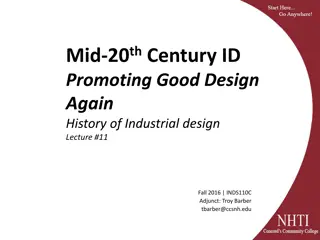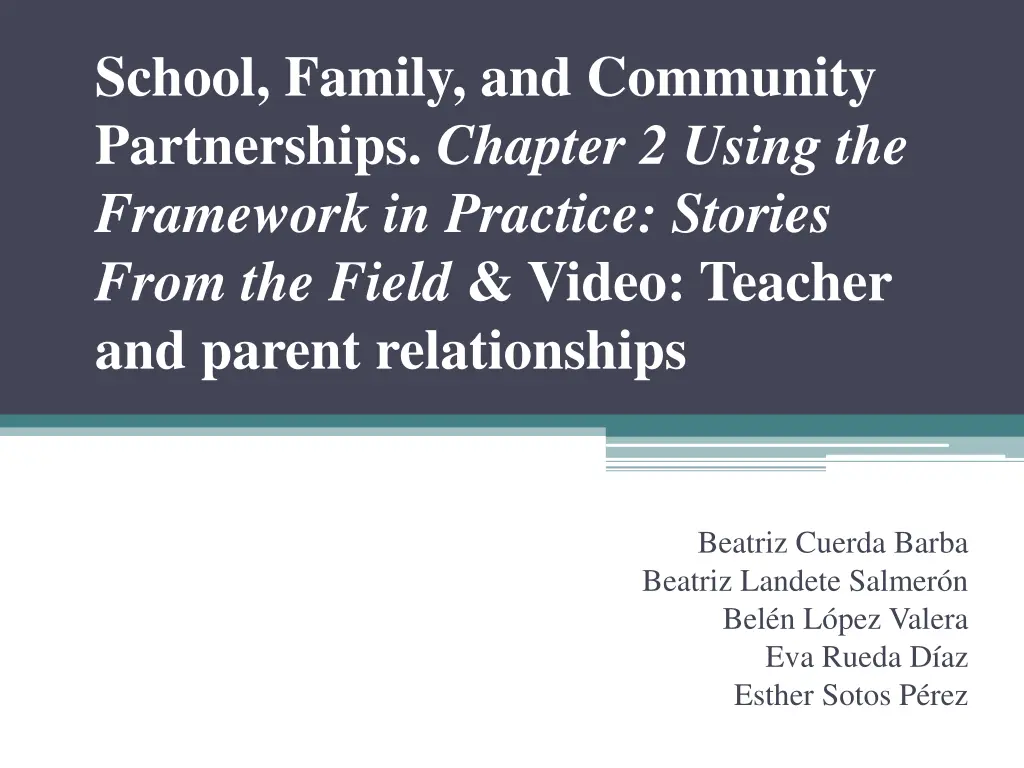
Effective School-Family-Community Partnerships: Enhancing Student Success
Discover how the collaboration between teachers and parents can positively impact students' learning and emotional development. Explore real-life examples of successful partnerships in education, emphasizing the importance of clear communication and mutual understanding.
Download Presentation

Please find below an Image/Link to download the presentation.
The content on the website is provided AS IS for your information and personal use only. It may not be sold, licensed, or shared on other websites without obtaining consent from the author. If you encounter any issues during the download, it is possible that the publisher has removed the file from their server.
You are allowed to download the files provided on this website for personal or commercial use, subject to the condition that they are used lawfully. All files are the property of their respective owners.
The content on the website is provided AS IS for your information and personal use only. It may not be sold, licensed, or shared on other websites without obtaining consent from the author.
E N D
Presentation Transcript
School, Family, and Community Partnerships. Chapter 2 Using the Framework in Practice: Stories From the Field & Video: Teacher and parent relationships Beatriz Cuerda Barba Beatriz Landete Salmer n Bel n L pez Valera Eva Rueda D az Esther Sotos P rez
Video: Teacher and parent relationships a crucial ingredient A lot of teachers and parents meet to communicate because parents are in so many different directions and so are teachers. The woman who talks is a parent education organizer, and teachers have spoken to her some of the things that they have done to make her be able to know what is going on in her child s classroom. The first day of her child at school, the teacher pass her a survey to know more about her child: personality, the way that he learn, and she started to think about those things. The next day the teacher and she met, they talked about the things both of them expected from each other. The presentation day of the teacher of her daughter was about: the expectations her teaching philosophy give parents some pieces of advice about how the reinforcing was going to be happening so that they could take it home and reinforce their children to do better in the classroom the strategies she used and why she was using them
She continue with 2 examples of what she was involved in a cooperation between teachers and parents for the good future of students reinforce students emotional relationships, changing what was wrong in the building The fact is that parents were able to see what those teachers were trying to accomplish. Teachers have to do so much more with so much less and parents need to understand that because if not then they just think: you are not doing your job; so we need to have that line of communication.
Actually, parents and teachers have talked to each other like adults, centre on the students expectations are for that school year being clear about the teaching philosophy and the strategies, because teachers want everyone to be on the same page at the beginning of the school year. If it wasn t for those lines of communication, she doesn t think they would have been able to do the things they did. Teachers working conditions are students learning conditions. If teachers translate what they need to do that school year they will get parents to be able to not just change the classroom but also can change the system.
SCHOOL, FAMILY, AND COMMUNITY PARTNERSHIPS. CHAPTER 2 USING THE FRAMEWORK IN PRACTICE: STORIES FROM THE FIELD
Introduction Framework of six types of family and community involvement and the action team approach are implemented in practice. Reports from leaders whose schools, districts, and states developed partnership programs. Importance of planning, evaluating, and continually improving activities
Type 1 Parenting Parenting activities increase families understanding of their children s growth and development. These activities also increase schools understanding of families with strategies that promote exchanges of information between educators, parents, and other caregivers about their concerns and goals for children.
Type 2 - Communicating School-to-Home Home-to-School Two-way communications by teachers and families increase understanding and cooperation between school and home. They also show students that their teachers and parents are working together to help them succeed in school.
Type 2 - Communicating Comprehensive communications campaign to improve student attendance Many different kinds of communications were designed and conducted with students, parents, teachers and the community to get everyone s help in increasing high school students attendance. South St. Paul High School
T Type 3: volunteering activity School support. Volunteers can do activities at school, in classrooms, at home. Families also give their time to attend events, sports activities.. Help strengthen school programs. Parent Resource Directory Washington Greeters Contribute
Volunteering activity The goal was recognize and use the talents, skills, and expertise of as many parents as possible. Parent Resource Directory Create a friendly way to welcome new visitors to the school. Washington Greeters Contribute
Type 4: learning at home Learning at home activities provide information and ideas to families about the academic work that their children do in class. Action Team for Partnerships storytelling time parents and students to enjoy reading together.
Storytelling Time Promotes Reading at Home This activity: Foster the importance of parents reading to their children. Demonstrated a variety of ways for parents to tell stories and build children s language skills. Gave families an opportunity to socialize and meet other families.
TYPE 5-DECISION MAKING ACTIVITY Organizing an Action Team for Partnerships co- Committee co-chairs chairperson Committee members chairperson Action Team
TYPE 6-COLLABORATING WITH THE COMMUNITY Type 6- Collaborating with the Community activities schools, families, and community groups, organizations, agencies, and individuals Encourage cooperation of Some community programs and services in their communities that schools, families, and students may use. Some tap business and community partners to design and implement big programs (e.g., afterschool programs) or projects (e.g., creating a new playground). schools begin by creating identify a portrait to the Hundreds of type 6 activities to connect schools, students and families with their communities
Family Involvement Coordinating Commiitee The Howard County Public School System (HCPSS) developed an action team approach at the district level. The objectives of the Family Involvement Coordinating Committee (FICC) were to (a) gain an awareness of all family- linked services and involvement activities across departments, identify and solve problems to better align family services, and evaluate the effectiveness of school, family, and community partnerships.
Family Involvement Notebook Schools are using the information in the notebooks to answer their basic questions about partnerships.
Parent Libraries on Wheels Local School District B (a district-area of the Los Angeles Unified School District- LAUSD) established Parent Libraries in all family centres in the district to help parents meet the challenges of child rearing and to improve student reading achievement. The Parent Libraries helped the district support families by making available accurate and relevant parenting information and children s literature. Materials that could be checked out included books, leaflets, audiotapes, videos, and other resources for parents in both English and Spanish.
STATE LEADERSHIP ACTIVITY Partnering With the United Way of Connecticut The United Way of Connecticut and the Connecticut State Department of Education signed an agreement to work together to build linkages between schools, families, and their communities. The purpose of this joint agreement is to: Support and extend the standards for partnerships. Increase public and private stakeholders awareness of the purpose and benefit of school-family-community partnerships. Encourage active partnerships between Connecticut s local affiliates of the United Way, schools, and other community organizations to support students optimal development and academic success.
Conclusion It is important to develop activities to prepare and support schools to plan and implement strong partnership programs with the families. By partnering with an important statewide organization that has strong ties to local community agencies, teams will seek to strengthen the community part of their school-family- community partnerships.
Questions True/False 1. According to the video: Teacher and parent relationships a crucial ingredient, teachers working conditions are parents cooperative conditions. False (Teachers working conditions are students learning conditions). 2. According to the book School, Family, and Community Partnerships (Chapter 2 - Using the Framework in Practice: Stories From the Field), parenting activities decrease families understanding of their children s growth and development. FALSE (Decrease Increase) 3. According with the document: School, Family, and Community Partnerships, chapter 2 . Parent volunteers who serve as assistants in programs or events classrooms help strengthen school programs. TRUE
4. According with the document: School, Family, and Community Partnerships, chapter 2 type 6-Collaborating with the Community activities encourage the cooperation of schools, families, and community groups, organizations, agencies, and individuals. TRUE 5. According with the document: School, Family, and Community Partnerships, chapter 2 the Family Involvement Notebook consists on using the information in the notebooks to answer their basic questions about partnerships. TRUE
Questions Multiple choice 1. According to the video: Teacher and parent relationships a crucial ingredient, a lot of teachers and parents can never meet to communicate because: a) parents are in so many different directions and so are teachers. b) teachers are in so many different directions. c) parents are in so many different directions. 2. According to the book School, Family, and Community Partnerships (Chapter 2 - Using the Framework in Practice: Stories From the Field), two-way communications by teachers and families increase: A) Understanding and cooperation between school and home. B) Partnership and cooperation between school and home. C) Understanding and partnership between school and home.
Questions: Multiple choice 3. According to School, Family, and Community Partnerships, chapter 2 thanks to storytelling activity........ a. Foster the importance of parents reading to their children. b. Demonstrated a variety of ways for parents to tell stories and build children s language skills. c. Gave families an opportunity to socialize and meet other families. d. All of the them. 4. According with the document: School, Family, and Community Partnerships, chapter 2 the Action Team for Partnership is formed by: a. Teachers and parents b. Chairperson, Co-chairperson, Committee co-chairs and Committee members c. Teachers, parents and pupils
According with the document: School, Family, and Community Partnerships, Chapter 2 The Parent Libraries : a)Helped the district support families by making available accurate and relevant parenting information and children s literature. b)Had materials that could be check out, as books, leaflets, audio tapes, videos, and other resources for parents in both English and Spanish. c)Both are correct.
References Video: Teacher and parent relationships a crucial ingredient. Document: School, Family, and Community Partnerships. Chapter 2 Using the Framework in Practice: Stories From the Field.

